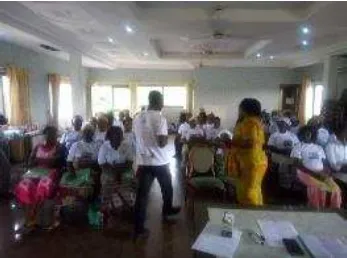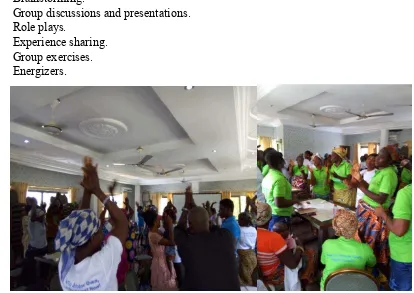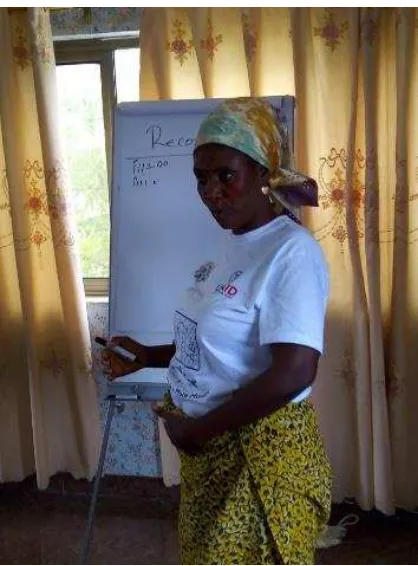SUSTAINABLE FISHERIES
MANAGEMENT PROJECT (SFMP)
This publication is available electronically in the following locations:
The Coastal Resources Center
http://www.crc.uri.edu/projects_page/ghanasfmp/
Ghanalinks.org
https://ghanalinks.org/elibrary search term: SFMP
USAID Development Clearing House
https://dec.usaid.gov/dec/content/search.aspx search term: Ghana SFMP
For more information on the Ghana Sustainable Fisheries Management Project, contact: USAID/Ghana Sustainable Fisheries Management Project
Coastal Resources Center
Graduate School of Oceanography University of Rhode Island
220 South Ferry Rd.
Narragansett, RI 02882 USA
Tel: 401-874-6224 Fax: 401-874-6920 Email: [email protected]
Citation: Development Action Association. (2017). Business Skills Services Training. The USAID/Ghana Sustainable Fisheries Management Project (SFMP). Narragansett, RI: Coastal Resources Center, Graduate School of Oceanography, University of Rhode Island and DAA. GH2014_ACT114_DAA 16 pp.
Authority/Disclaimer:
Prepared for USAID/Ghana under Cooperative Agreement (AID-641-A-15-00001), awarded on October 22, 2014 to the University of Rhode Island, and entitled the USAID/Ghana Sustainable Fisheries Management Project (SFMP).
This document is made possible by the support of the American People through the United States Agency for International Development (USAID). The views expressed and opinions contained in this report are those of the SFMP team and are not intended as statements of policy of either USAID or the cooperating organizations. As such, the contents of this report are the sole responsibility of the SFMP team and do not necessarily reflect the views of USAID or the United States Government.
Detailed Partner Contact Information:
USAID/Ghana Sustainable Fisheries Management Project (SFMP) 10 Obodai St., Mempeasem, East Legon, Accra, Ghana
Telephone: +233 0302 542497 Fax: +233 0302 542498 Maurice Knight Chief of Party [email protected]
Kofi Agbogah Senior Fisheries Advisor [email protected] Nii Odenkey Abbey Communications Officer [email protected]
Bakari Nyari Monitoring and Evaluation Specialist [email protected] Brian Crawford Project Manager, CRC [email protected]
Ellis Ekekpi USAID AOR (acting) [email protected]
SNV Netherlands Development Organisation #161, 10 Maseru Road,
E. Legon, Accra, Ghana 233 30 701 2440 Donkris Mevuta Kyei Yamoah
[email protected] Friends of the Nation Parks and Gardens Adiembra-Sekondi, Ghana
Darkuman Junction, Kaneshie Odokor Highway
ACRONYMS
DAA Development Action Association FtF Feed the Future
GNCFC Ghana National Canoe Fishermen’s Council SFMP Sustainable Fisheries Management Project SMEs Small and Medium Enterprises
TABLE OF CONTENTS
CONTENTS
ACRONYMS ... iii
TABLE OF CONTENTS ... iv
LIST OF FIGURES ... v
LIST OF TABLES ... v
EXECUTIVE SUMMARY ... vi
SECTION 1 INTRODUCTION ... 1
1.1 Objectives ... 1
1.2 Expected Outcomes ... 2
1.3 Attendance ... 2
SECTION 2 IDENTIFICATION, SCREENING AND NEEDS ASSESSMENT ... 2
SECTION 3 TRAINING CONTENT ... 3
3.1 Training Venue and Other Logistics ... 3
3.1.1 Organization ... 3
3.2 Training Delivery ... 4
3.3 Expectations ... 4
SECTION 4 METHODOLOGY... 5
SECTION 5. CONTENT OF THE TRAINING ... 5
SECTION 6. TRAINING OUTCOMES ... 6
6.1 Training Workshop Evaluation ... 8
SECTION 7. CONCLUSION ... 8
7.1 Challenges ... 8
7.2 Lessons Learnt ... 9
7.3 Recommendations ... 9
LIST OF FIGURES
Figure 1 Facilitators setting the rules for the Training ... 1
Figure 2 Madam Emelia Nortey facilitating the SMEs on Proper Records Keeping ... 4
Figure 3 Participants energizing themselves during the training ... 5
Figure 4 Madam Mercy Frimpong sharing the importance Record Keeping with the participants ... 6
Figure 5 Traditional Book Keeping by Fish Processors ... 6
Figure 6 Madam Grace Bondzie from Apam demonstrating how she keeps records ... 7
Figure 7 Madam Stella Quartey demonstrating how she keeps records ... 7
LIST OF TABLES
Table 1 List of Fish Processor Groups and SMEs Identified and Screened ... 3EXECUTIVE SUMMARY
SECTION 1 INTRODUCTION
The role of women in the fishing and fish processing sector is enormous in supporting household income and livelihoods. However, the fishing industry is confronted with many challenges. Central among them is the management of the fishing business itself as a means of generating sustainable income to better their lives. Apart from fishing from the sea; which is predominantly a male activity, all other fishing related businesses are mostly undertaken by women. These women in their daily business activities continue to battle with proper record keeping and costing all inputs in their processing sector. Due to improper record keeping coupled with poor costing of processing inputs, these had led to low income and low profit margins of most processors in the country. The situation had made the standard of living in the fishing communities very poor and the children are those that suffer since they go through child labor and trafficking due hardship.
It is in view of the above that Development Action Association (DAA), under the Sustainable Fisheries Management Project (SFMP) with sponsorship from USAID, came on board to circumvent the situation by supporting some SME’s within selected fishing communities through facilitating Business advocacy training services to equip them with proper record keeping and better ways of costing items and products. The Business skills training took place at Gloriaka Hotel at Winneba junction. In all 150 SME’s were trained. The SME’s were divided into 3 batches for the training. The first batch was trained on the 9th to 10th March,
2017, the second batch 21st to 22nd March, 2017 and 23rd to 24th March, 2017 for the last
batch.
Figure 1 Facilitators setting the rules for the Training
1.1 Objectives
To empower the women to be able to manage their businesses financially
To reduce post-harvest losses through training in proper record keeping
To observe good sanitation practices at the landing and processing sites
1.2 Expected Outcomes
Expected outcomes of Training included:
To improve knowledge in basic record keeping.
To train SMEs on costing and book keeping practices.
To observe personal hygiene before, during and after processing fish.
To develop marketing and packaging skills.
How to create good customer relationship
How to get good market for the processed fish. 1.3 Attendance
The business skills training was attended by 150 SMEs from Apam, Mumford and Winneba Communities of which 9% were Male MSMEs; while 136 MSMEs were Female SMEs.
SECTION 2 IDENTIFICATION, SCREENING AND NEEDS
ASSESSMENT
Before the commencement of the training DAA identified and screened 180 SME’s in which 150 of the SME’s were selected for discussion of the training needs assessment with them. The meeting helped to discuss with the trainees the specific knowledge gaps.
Equally, trainers met and had discussions with DAA field staff to ascertain the training needs of the beneficiaries, in order to help facilitate the design of appropriate interventions in terms of training materials suitable to achieve the goal. The parties also agreed on the training venue, date and time appropriate for the training.
The selected beneficiaries were also screened before final selection, using SME’s identification and assessment tool provided by the SFMP.
The screening exercise took place at Apam, Mumford, Winneba, Akosua Village and Warabeba.
Table 1 List of Fish Processor Groups and SMEs Identified and Screened
Name of fish processor Group Total number of MSMEs Identified and Screened
Dwamaman Co.operative 25
Apam fish processors Association 16
ONO fish processors Group 23
Anomansah fish processors Group 26
Osakam fish processors group 20
Norvisi fish processors group 6
Adom Nnsa fish processors group 26 Boafo ye Nam fish mongers Association 16 Osimpam fish processors group 22
Total 180
Out of a total number of 180 MSMEs identified and screened, 75% of them smoke fish, 30 of them process salted and dry fish, 10 of them sell fresh fish at the landing beach, while 5 of them are inputs dealers.
SECTION 3 TRAINING CONTENT
Prior to the training, the trainers met to discuss the training materials relevant to make maximum impact on the trainees. This was very important since business skills training require proper planning. The participants were provided with key notes as well as reference, files, pens, writing pads etc. in adequate proportion.
3.1 Training Venue and Other Logistics
The training was non-residential for the participants and was conducted for eight hours for the first day, six hours for the last day. The venue was the Gloriaka conference room, which was spacious enough for movement and group exercises. The venue was easy to locate. The training materials were available, in correct specifications and were adequate. Snacks and lunch were also provided.
3.1.1 Organization
3.2 Training Delivery Workshop Process Opening
The facilitator from Development Action Association, (DAA) Madam Emilia Nortey opened the training session with a welcome address. She went ahead to give a brief background of the Sustainable Fisheries Management Project (SFMP) as a 5- year fisheries food security project funded by United States Agency for International Development (USAID), under the mission’s Feed the Future (FtF) Programme. The project seeks to rebuild targeted marine fisheries stock (small pelagics) such as herrings, mackerel, anchovies and sardinella which are important to local food security; and supports livelihoods through the adoption of
sustainable fishing practices. She encouraged the participants to take the training seriously by giving their full attention to the facilitators and asking questions for clarification.
Thereafter, a brief address on the purpose of the training was given and also urged all beneficiaries to see it as a privilege to receiving the training.
SECTION 4 METHODOLOGY
The methodology used for the training was combined with participatory Rural/Learning Appraisal method (PRA).
Some of the tools include the following:
Brainstorming.
Group discussions and presentations.
Role plays.
Experience sharing.
Group exercises.
Energizers.
Figure 3 Participants energizing themselves during the training
SECTION 5. CONTENT OF THE TRAINING
During the training delivery a wide range of subject areas were covered. Participants were taken through the following topics:
The meaning of Business.
Business Ideas.
When has a Business Failed.
Avoid pitfalls for business collapse.
The meaning of costing.
Types of cost.
Classification of cost.
Pricing of goods/products and services.
Profit and Loss analyses.
Record keeping.
The meaning of saving.
The meaning of marketing.
Key ingredients in marketing.
SECTION 6. TRAINING OUTCOMES
Figure 4 Madam Mercy Frimpong sharing the importance Record Keeping with the participants
Figure 6 Madam Grace Bondzie from Apam demonstrating how she keeps records
Madam Grace Bondzie, a fish processor from Apam demonstrating how she keeps her records. “The Business Skills training organised by DAA under the SFMP has helped me to improve upon my customer relationship skills. I can now relate more cordially with my customers than before.”
Figure 7 Madam Stella Quartey demonstrating how she keeps records
6.1 Training Workshop Evaluation
Table 2 Workshop Evaluation
AREA OF EVALUATION GOOD NOT
SURE
NOT GOOD The training contents were suitable to my business
needs.
141 3 6
The number of days were suitable for the training 142 4 4 The trainers/facilitators were effective and explained
the modules well
140 4 6
The venue was approprate and conducive 129 8 13
I am confident of putting into practise the things I have learned from this training.
141 5 4
From the Training Evaluation Table, 95% of the participants indicated that the training contents were suitable for their fish processing business, 2 participants were not sure if the training contents were suitable to their business needs; while 4% of the participants said that the training contents were not suitable for their business needs.
With the number of days for the training, 142 participants evaluated that the number of days were suitable for the training, 3% of them were not sure if the number of days were suitable for the training or not, while 3% evaluated that the number of days for the training were not suitable.
140 participants were satisfied with the facilitators as well as effetiveness of the facilitators in explaining the training modules to them. Four (4) participants were not sure of the
effectiveness of the facilitators or the modules, while 4% of the participants were not satisfied with the facilitators as well as the training modules.
Also 86% of the participants trained evaluated good for the venue being conducive for the training, 5% of the participants were either satisfied with the venue or not, 9% of participants evaluated that the venue was not conducive for the training.
7.2 Lessons Learnt
The trained MSMEs proved beyond all reasonable doubt that being illiterate was not a barrier to upgrade oneself.
The adoption of the participatory approach for the training workshop developed and sustained the interest of the participants throughout the training period.
It takes gradual process in building the trust in the constituent. 7.3 Recommendations
Fish processors engagement should be timely with the fish season.
Micro finance project should be introduced to the trained SMEs to help them in their fish processing businesses, since most of them are craving for soft loans.
7.4 Way Forward






